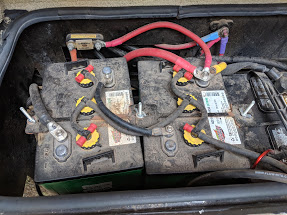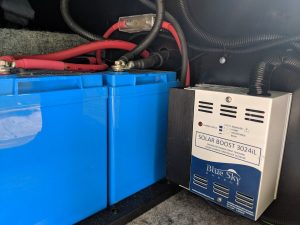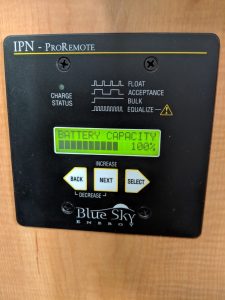Okay, that’s just silly! But this post is about power. Specifically, how I store it. Let me explain.
When my ex and I bought the motorhome in 2016 it still had the original 12-volt marine batteries that were installed at the factory in 2010 (it’s a 2011 but was manufactured in July of 2010). The batteries were pretty much toast but the original owner only camped at places with electric hookups so they didn’t care, or perhaps didn’t even notice.
So in April of last year I replaced those two 12-volt marine batteries — marine batteries are sort of a hybrid between a starter battery and a deep cycle battery — with two 6-volt deep cycle golf cart batteries wired in series. These were standard flooded lead acid batteries that require periodic topping off of the water, and which emit gases and therefore require venting. This was fine as they went into the battery compartment under the stairs which is open to the outside and thus well ventilated. I installed a watering system to make keeping the water at the proper level in each cell a trivial job.
Fast forward to March of this year. I’d gone through the winter doing a good bit of boondocking and dry camping (camping without hookups) in National Parks, depending on a small portable solar panel and my generator to keep my batteries charged. I made a return trip to Quartzsite specifically to have some solar installed on the motorhome. I had three 160 watt solar panels installed on the roof, for a total of 480 watts, as well as a solar charge controller and monitor. But generating all that electricity is useless unless you can store it for when you need it, so I also expanded my storage by adding two more batteries.
My battery compartment will only hold the three batteries that were already there; the two 6-volt house batteries I had installed last April, and the chassis battery. The only logical place to put the new additional batteries was in one of the basement storage compartments. In order to install more flooded batteries I would need a battery box installed and vented to the outside. Instead of doing this, I had two 6-volt deep cycle AGM batteries installed. AGM batteries are sealed so they can be installed without venting. It’s less than ideal to mix AGM and flooded batteries, but I didn’t have the money to replace my flooded batteries with AGMs at the moment.
One of the good parts of spending the summer in one place is that I’m not spending money buying gas to travel, so I had the extra cash to finally buy two more AGM batteries, and today I swapped out the flooded batteries for the new AGMs. I now have four matching batteries.
This completes the first half of the project; generating electricity and storing it for use. Now that I’ve got a fair amount of power on tap, I need to make some modifications to the power distribution in the motorhome so I can take full advantage of it. That will come later; probably next spring.





Very very cool thing to do. I am impressed by your expertise in things electrical. How long do you think it will take to recover in energy your financial investment?
Measured purely financially, I doubt I’ll ever reach the “payoff point” of the solar. The money spent on solar could buy an awful lot of gas to power the generator.
It’s about convenience, and the peace and quiet of not having to listen to the damned generator chugging away. It’s also about living comfortably in places where generator use is frowned on, or even prohibited.
I love to visit national parks, and many national park campgrounds strictly limit the hours you are allowed to run your generator, or outright prohibit them. And when boondocking, you can quickly become that annoying neighbor by running your generator too much.
As I alluded to in the post, right now I can’t make full use of the power I’m generating and storing. I hope to get that taken care of over the winter when I get back to Quartzsite at the end of February, after the mad rush of January.